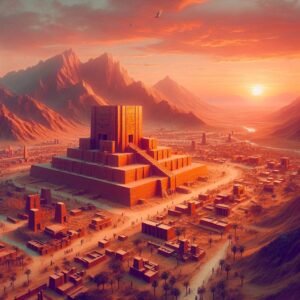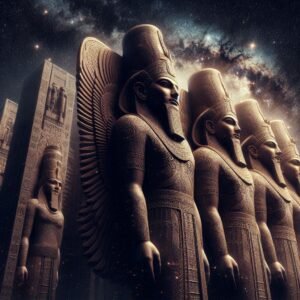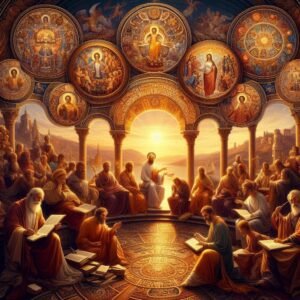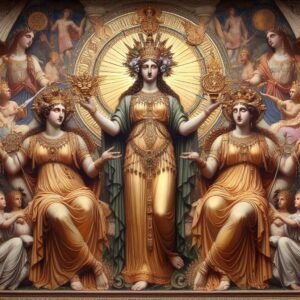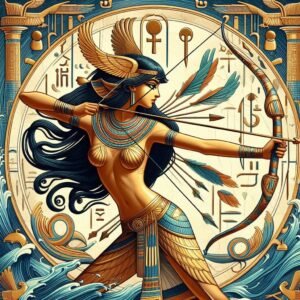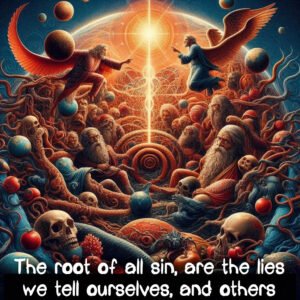The Sumerian cosmology is a fascinating blend of mythology and early scientific thought. The Sumerians envisioned the universe as a closed dome surrounded by a primordial saltwater sea. The earth was seen as a flat disc beneath this dome, with an underworld and a freshwater ocean called the Abzu beneath it.
Category: Religion
Permanent link to this article: https://truthofself.com/the-sumerian-cosmology/
Jul 12
The Goddess Ishtar
Ishtar, known as Inanna in Sumerian, is a deity of profound complexity and significance in Mesopotamian mythology, embodying the dualities of existence such as love and war, fertility and desolation. Her worship spanned across the ancient Near East, marking her as one of the most venerated figures in early human civilization
Permanent link to this article: https://truthofself.com/the-goddess-ishtar/
Jul 12
The Goddess Nammu
Nammu is a primordial goddess in Sumerian mythology, often associated with the creation of the universe and humanity. She embodies the primeval waters, an elemental force from which life and the pantheon of gods emerged. As a creator deity, Nammu’s role is pivotal in the cosmogony of Mesopotamian belief systems, where she is revered as the mother who gave birth to the major deities, including Enki, the god of wisdom, water, and creation.
Permanent link to this article: https://truthofself.com/the-goddess-nammu/
Jul 12
The God Enki
Permanent link to this article: https://truthofself.com/the-god-enki/
Jul 12
The God Anu
Permanent link to this article: https://truthofself.com/the-god-anu/
Jul 12
The Citadel of Erbil
Permanent link to this article: https://truthofself.com/the-citadel-of-erbil/
Jul 12
The Geography of Sumeria
Permanent link to this article: https://truthofself.com/the-geography-of-sumeria/
Jul 12
The Sumerian reverence for rivers
The Sumerians, deeply connected to the Tigris and Euphrates rivers that cradled their civilization, had a profound reverence for these waterways, which was reflected in their religious rituals. One such ritual was the ‘mîs-pî’, an intricate ceremony that involved the ‘washing of the mouth’ of divine statues, symbolizing purification and the induction of life into the idols.
Permanent link to this article: https://truthofself.com/the-sumerian-reverence-for-rivers/
Jul 12
The Sumerian City of Uruk
Permanent link to this article: https://truthofself.com/the-sumerian-city-of-uruk/
Permanent link to this article: https://truthofself.com/the-beliefs-of-ancient-mesopotamia/
Permanent link to this article: https://truthofself.com/the-anunnaki-and-the-birth-of-the-cabal/
Permanent link to this article: https://truthofself.com/blood-sacrifice-anyone-have-some-black-pudding/
Jul 07
Syncretism in early Christianity
This article explains how the syncretism observed in early Christianity, where elements of Roman, Hellenistic and other religions were integrated into Christian practices, means that in many Christian places of worship, traces of earlier, pagan beliefs can be found, and that many churches and local Christian customs are directly connected to those earlier beliefs.
Permanent link to this article: https://truthofself.com/syncretism-in-early-christianity/
Jul 06
Syncretism
Permanent link to this article: https://truthofself.com/syncretism/
Permanent link to this article: https://truthofself.com/primordial-goo-and-the-mother-of-creation/
Jun 23
The Egyptian Goddess Neith
Permanent link to this article: https://truthofself.com/the-egyptian-goddess-neith/
Jun 17
The concept of paradise as a walled garden
In this article, we will delve into the origins of this metaphor, tracing its roots from the ancient Persian gardens to its adoption in various cultural and spiritual contexts. We will explore how the notion of a walled garden has evolved, influencing art, literature, and garden design, and how it continues to shape our understanding of paradise.
Permanent link to this article: https://truthofself.com/the-concept-of-paradise-as-a-walled-garden/
Jun 14
The nature of sin, and the trouble with interpretation
If you understand that in biblical terms, the root of all sin, is lies. And that it is the lies we tell ourselves, and act on as if they were true, which causes sinful behaviour. And that a huge lie a number of people tell themselves, is that they are normal, which means they are conforming to some standard of normality that they have adopted from external influences.
Permanent link to this article: https://truthofself.com/the-nature-of-sin-and-the-trouble-with-interpretation/
Jun 11
Where is your enemy?
Permanent link to this article: https://truthofself.com/where-is-your-enemy/
Jun 11
Matthew 4 – Satan tempts Jesus, reinterpreted
The story of the temptation of Christ, is a merging of three different visits by the devil, and the very last thing that happened was the testing for 40 days and 40 nights. I’ve tried to word it more accurately, but I too have distorted the truth, somewhat, to do that. To make it more understandable in the context of the original summarisation.
Permanent link to this article: https://truthofself.com/matthew-4-satan-tempts-jesus-reinterpreted/






